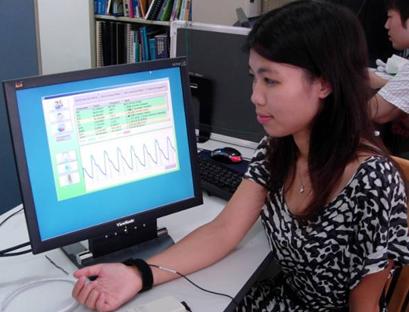Great news for those who want to accurately monitor their cardiovascular health status! The “e-Home Healthcare” system, which has been developed with the technical support from the University of Macau (UM), will spare users the trouble of going to the hospitals. With this system, users can monitor their cardiovascular health status in the comfort of their homes. Moreover, users can get monitoring results and early warning messages through various telecommunication equipment such as computers, smart phones and PDAs, thus preventing cardiovascular diseases and the resulting pathological conditions.
Cardiovascular diseases are complicated. The severity and symptoms vary from patient to patient. External factors such as seasonal and temperature changes and air pollution also play an important role. Therefore, accurate monitoring of the cardiovascular health status is of extreme importance. The “e-Home Healthcare” system, which was developed by the research team from The Institute of Systems and Computer Engineering of Macau (INESC-Macau), with the funding from the Macao Science & Technology Development Foundation FDCT and the Research Committee of UM and the technical support from UM, allows users to monitor their cardiovascular health status at home and take more relevant healthcare measures based on the monitoring results. The project took more than three years to complete. Yesterday (9 April 2010) the INESC-Macau, the Faculty of Science and Technology (FST) of UM, and the Biomedical Engineering Laboratory of UM, jointly held a presentation to update the audience on the operation method, technical features, hospital testing results and future R&D direction of the system.
Through a combination of software and hardware, the “e-Home Healthcare” system allows users to monitor their cardiovascular health status at home through personal computers or the Internet. It noninvasively samples the sphygmorgram i.e. the wrist pulse waveform; utilizes various techniques such as wavelet analysis, support vector machines, and dynamic study of intracranial arterial blood flow to process and analyze the collected pulse waveform; and then uses artificial intelligence and computer-aided cardiovascular expert diagnostic techniques to process, analyze and diagnose the collected data. Through such a process it can quickly diagnose the users’ cardiovascular health status and give early warning messages. Moreover, the health index curve obtained through the long-term monitoring enables users to know their cardiovascular health trends and take more relevant healthcare measures.
The “e-Home Healthcare” system adopts innovative, state-of-the-art technologies such as 2-dimension physiological signal feature characterization technique, multi-dimension mapping relationship model between pathophysiological symptoms and diseases, hybrid biomedical signals intelligent processing and medical decision-making support technique, intelligent analysis concerning uncertainty cases and pattern recognition based on fuzzy inference and prognosis etc. . Novel functions and features of the system include:
1)User-friendly interface with powerful functions, easy to use.
2)obtain stable and reliable pulse waveform via real-time signal auto-adjustment;
3) Intelligently extract and process the feature points from waveform and derive 32 hemodynamic-related cardiovascular health indices through designed model, which reflect the health status of the heart, blood vessels, blood and microcirculation;
4) Adopt a cardiovascular parameter indicating system similar to the traffic lighting system, with pink meaning beyond normal range, green meaning within normal range, and yellow meaning critical value.
5) An analysis model based on medical knowledge to enable fast analysis results and early warning messages.
6) Provide early warning messages in case the cardiovascular parameter is beyond the normal range; offer further explanation and useful information for reference at the click of the warning messages.
7) Automatically generate the long-term health indices curve to enable users to know the health status of their cardiovascular systems.
8) Store historical pulse waveform data, analysis results and early warning messages in the users’ individual files, thus more reliably predicting the potential pathological changes of the cardiovascular system;
9) Remote online intelligent analysis and system updating: by uploading the sampled physiological data to the backyard health center through the Internet, the feedback of in-time analysis results, which are obtained through the server’s more precise and reliable computing and reasoning based on his mass clinical records, medical knowledge and historical data, will be displayed on the front client’s displayer, and the client’s medical knowledge base will be simultaneously and automatically updated.
10) Suitable for family use, user-friendly design to enable independent operation by an adult user.
Samples of this system have been tested by two registered hospitals in Guangxi Province and Beijing, one nursing home in Zhejiang Province, and an insurance company in Macao, which shows that its precision and stability both meet expectations. So far the research team has published seven high-level international and domestic journal papers and 19 conference papers. Another six papers have been included as the book chapters individually. In addition, application for the contrivance patent of China has passed the preliminary inspection and is now in the public announcement phase.

